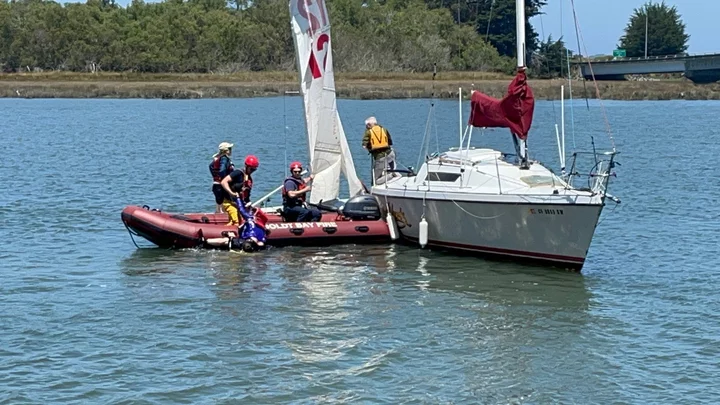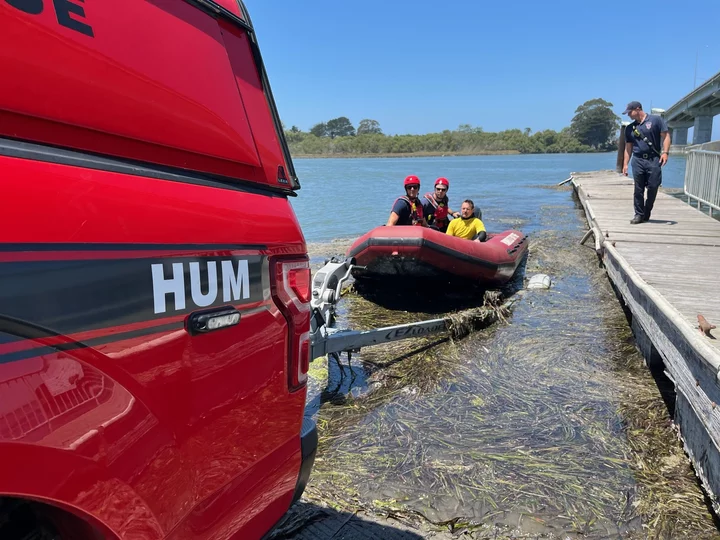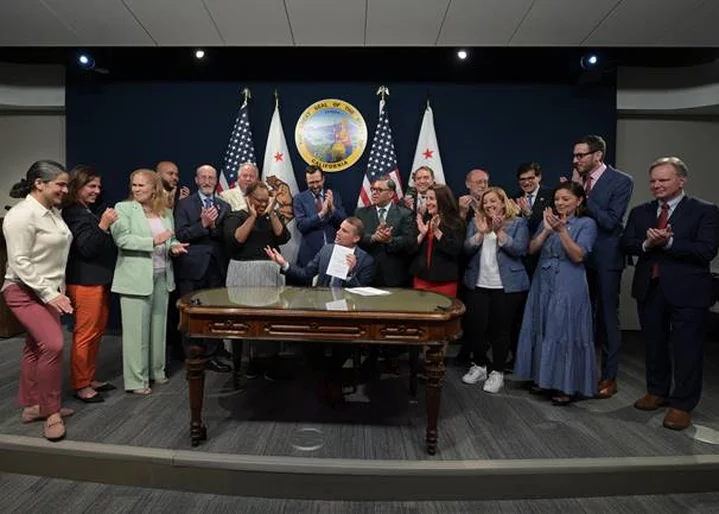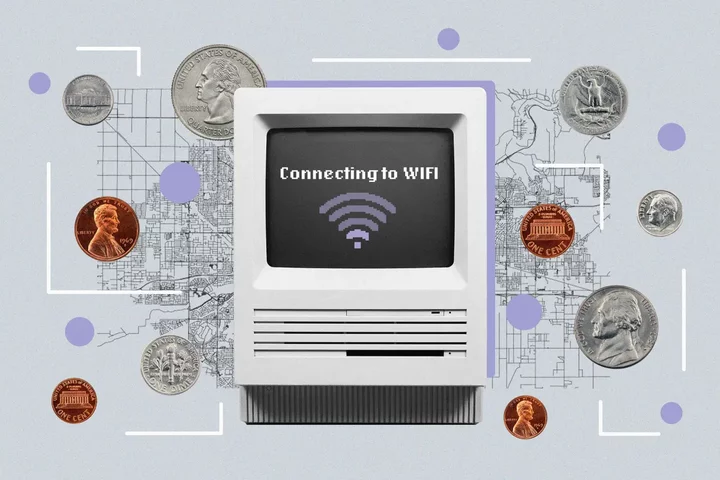OBITUARY: Donna Jean Alcorn Goddard, 1934-2024
LoCO Staff / Friday, July 5, 2024 @ 6:56 a.m. / Obits
Donna Goddard
November 5,
1934 – June 30, 2024.
Donna
Goddard passed away Sunday June 30, 2024 at the age of 89. She
was born November 5,
1934, in Sanger to Granville and Alice Alcorn.
In
1952 the family moved to Westhaven, where Donna graduated from Arcata
High School. Donna met and married her lifelong love, Don and
together they had four children. Donna loved her family and was a
good mom, auntie, grandmother and great-grandmother.
Donna
was never afraid of a hard day’s work and had some very interesting
jobs; she worked as a switchboard operator at the local phone
company, tallied lumber for Arcata Redwood, ran North Bay Firewood
with her son, Gary, and even operated the chop saw at Simpson Timber
Company. In her time off she enjoyed spending time with family and
friends at their place in Redwood Creek, fishing on the Klamath, and
bowling; in fact, she was an expert (competitive) bowler, with many
trophies to prove it.
Donna
is survived by her children, Renee, David, Gary, and Susan;
grandchildren, Jennifer, Bobbi, Josh, Cody, and Tucker; and
great-grandchildren, Layla, Cameron, Kaileigh, Camerin, Tyler, Invy
and Abby. Donna was preceded in death by her husband, Don; her twin
sister, Norma; her parents Granville and Alice Alcorn; brothers,
Clyde, Virgil, and “Kenny” Ken Alcorn.
A graveside service will be held at Greenwood Cemetery, 1757 J St., Arcata on Wednesday July 10 at 1 p.m. Services are under the direction of Paul’s Chapel, 1070 H St. Arcata. In lieu of flowers please send donations in Donna’s name to the Senior Resource Center in Eureka.
###
The obituary above was submitted on behalf of Donna Goddard’s loved ones. The Lost Coast Outpost runs obituaries of Humboldt County residents at no charge. See guidelines here.
BOOKED
Yesterday: 5 felonies, 6 misdemeanors, 0 infractions
JUDGED
Humboldt County Superior Court Calendar: Today
CHP REPORTS
No current incidents
ELSEWHERE
The Oregonian: Western renewable energy labs, research would lose big under Trump budget
Willamette Weekly: Founding Father of Oregon Psilocybin Fined for Breaking Rules He Helped Establish
Politico: CBO: Republican megabill to cost $4.1T, due to higher borrowing costs
OPB: In wildfire-prone Washington, ‘collaboration’ on forest management gives way to timber interests
Busy Fourth of July for Humboldt Bay Fire: Vegetation Fire Extinguished, Passengers in Overturned Sailboat Rescued
LoCO Staff / Thursday, July 4, 2024 @ 5:33 p.m. / Fire
Press release from Humboldt Bay Fire:
On 7/04/2024 from the hours of approximately 10:00 a.m. to 2:00 p.m. Humboldt Bay Fire has responded to multiple incidents, including a vegetation fire fire that spread from a transient encampment, and a water rescue near the Samoa bridge.
At just after 12:00 pm an engine, ladder truck, and Battalion Chief from HBF responded to a vegetation fire in the marsh area near 6th and V St. Multiple callers reported hearing explosions with flames seen in the greenbelt marsh areas. Units arrived to find an unoccupied transient encampment on fire that had spread into surrounding vegetation amounting to approximately a quarter acre. Humboldt Bay Fire spent approximately an hour extinguishing the fire. No civilians nor any firefighters were injured.
As the vegetation fire incident was wrapping up at 12:55 pm Humboldt Bay Fire was called to a water rescue for a sailboat overturned and in distress with multiple people in the water under the Samoa Bridge.
Several units with specialized water rescue personnel along with our water rescue boat responded to the scene. A Humboldt Bay Fire rescue swimmer entered the water to assist the two distressed boaters, and then assisted them into our rescue boat. Humboldt Bay Fire personnel then assisted their distressed vessel back to the Woodley Island Marina. Thankfully no one was injured during the incident.
Humboldt Bay Fire continues to provide a diversified skill set to mitigate various types of emergencies of our community. As we assist our citizens we thank you for your continued support of the fire department.Humboldt Bay Fire would like to remind everyone that only safe and sane fireworks with a seal from the State Fire Marshal’s office are legal and safe to enjoy. No aerial fire works are permitted. Each year hundreds of people are injured from illegal fireworks.
We also remind you that as the weather heats up, even in the greater Eureka area, to exercise safety in and around bodies of water. Whether it is the bay, pools, or rivers be mindful of your personal safety and those around you!
With a Swoop of His Pen, Governor Mike McGuire (Acting) Makes Bills From the Legislature the Law of the Land, Places $20 Billion in Bond Measures on Fall Ballot
LoCO Staff / Thursday, July 4, 2024 @ 12:45 p.m. / Sacramento
PREVIOUSLY:
###
Press release from the office of Senate President Pro Tem Mike McGuire:
Tonight, joined by leaders of the Senate and Assembly, Acting Governor Mike McGuire signed groundbreaking legislation headed for the November ballot. These include two bond measures that would provide critical investments for California public schools, and investments to connect communities with clean drinking water, and protect them from floods and the growing threat of wildfires.
The bond measures focus on modernizing classrooms and school campuses, which would benefit millions of California students, and investing in wildfire prevention and recovery, clean water, and better preparing the Golden State for the impacts of climate change.
“These historic bond measures passed by the Legislature are critical investments for our kids, they’ll make our communities more wildfire safe and connect tens of thousands of homes in every corner of the Golden State with clean drinking water,” Acting Governor McGuire said. “Even in the richest economy in America, tens of thousands of kids attend schools not up to 21st century standards. The education bond will ensure California’s students attend safe and modern schools free of lead paint, lead pipes, and free of leaky roofs. The safe drinking water and wildfire prevention bond will sustain and enhance quality of life in the Golden State by providing communities the resources they need to protect themselves from the growing threat of wildfires and floods, and help protect them from the impacts of extreme heat. We’re grateful to the legislative leaders who worked so incredibly hard to get these life-changing measures across the finish line.”
SB 867, the Safe Drinking Water, Wildfire Prevention, Drought Preparedness, and Clean Air Bond Act of 2024, would provide $10 billion to help communities avoid and recover from the impacts of wildfire, flood, drought, and other climate-related events. The strategic investments include funding for safe drinking water and drought, flood, and water resilience, as well as investments in wildfire and forest resilience, sea-level rise, extreme heat mitigation, clean air, and protecting biodiversity and promoting natural solutions. If approved by voters, the clean water and wildfire bond would be the single largest investment in public funding for climate resilience in California’s history.
AB 247, the Kindergarten Through Grade 12 Schools and Local Community College Public Education Facilities Modernization, Repair, and Safety Bond Act of 2024, would provide $10 billion in bond funding for education facilities modernization, repair and safety, and would be split between K-12 schools ($8.5 billion) and California Community Colleges ($1.5 billion). The funding would be designated for improvements that include new construction, modernization of schools, career technical education, heating and energy efficiency grants, and other needs.
Acting Governor McGuire also signed AB 440, an omnibus bill containing three provisions necessary to complete work on the 2024 General Election ballot, including moving ACA 13 to the 2026 General Election, ensuring the bond measures will be before voters in November, and assigning ballot numbers.
Why Many Illegal Fireworks Could Be Gone in California Next July Fourth
Jenna Peterson / Thursday, July 4, 2024 @ 7 a.m. / Sacramento
A legal fireworks stand in the city of Vernon sells fireworks that aren’t aerial and don’t explode, on July 2, 2024. The stand is operated by the Rotary club in Vernon. Photo by Ted Soqui for CalMatters
For eight years, Mike Salazar has spent Fourth of July week selling fireworks in an empty parking lot in Vernon. His truck is covered floor to ceiling with boxes of small snappers, sky rockets and $500 pre-built show packages.
“By the Fourth, there’s been times where we’ve been able to sell out everything and be out of here by 2 o’clock,” Salazar said. “I’ll be trying to close and people stop by saying, ‘I’ll buy whatever’s left!’”
The stand is one of hundreds across the country owned by TNT Fireworks, generating $110 million in revenue in California. It is already the country’s largest distributor of consumer fireworks.
Now, the company is trying to get California to crack down on illegal fireworks, including those sold in Nevada — and maybe boost its sales.
While “safe and sane” fireworks — including sparklers, smokeballs and noisemakers — are legal in many cities throughout California, projectile and explosive fireworks are illegal everywhere in the state.
So far this year, California has seized more than 120 tons of illegal fireworks, which is “well above” average, state Fire Marshal Daniel Berlant said in a press conference Tuesday. Last month, police seized 75 tons of illegal fireworks from a warehouse in Gardena — the largest bust in California’s history.
“It’s a glaring, shocking example of how the problem has grown to such proportions that there is so much more out there in this state, that something has to be done about it,” said Dennis Revell, CEO of Revell Communications, which represents TNT Fireworks.
Every Fourth of July, police and fire departments get swamped with calls about illegal fireworks.
Revell said that many illegal fireworks are coming from stores in Nevada counties where all fireworks are legal — some just eight miles from the California border.
In 2021, the Los Angeles Police Department detonated 16 tons of illegal fireworks found in a South Los Angeles home, injuring 17 people and displacing residents of the neighborhood. The city just reached a $21 million settlement with the affected families. The owner of the fireworks testified that he purchased most of them from Area 51, a store in Pahrump, Nevada.
Seeking an agreement with Nevada
Since January 2023, TNT Fireworks has spent more than $300,000 on lobbying California’s Legislature, governor’s office, fire marshal, Cal Fire and the attorney general’s office, according to the Secretary of State’s office. The company has donated nearly $7,000 to campaigns this election, including $2,000 to Assemblymember Eduardo Garcia, a Coachella Democrat and the author of Assembly Bill 1403, the focus of its lobbying efforts.
Last year, the Legislature passed and Gov. Gavin Newsom signed the bill, which doubled the range of illegal firework fines. The maximum — for possessing at least 5,000 pounds — jumped from $50,000 to $100,000.
An earlier version of the bill set aside a portion of the state sales tax on “safe and sane” fireworks to fund increased statewide enforcement against illegal fireworks. The provision was removed, and that’s when Revell came up with a new plan that he proposed to a fire marshal’s advisory committee: California and Nevada should work together to stop illegal firework sales earlier.
Firework stores in Nevada are already required to log information about their customers, including their ID. Through an interstate compact, Revell said, Nevada could require stores to put this information into a state database and alert California law enforcement when a California resident buys fireworks that are illegal here.
The proposal is now in Berlant’s hands. He’s reviewing it, and if it moves forward, Berlant will present it to Gov. Gavin Newsom’s office, which would discuss it with Nevada Gov. Joe Lombardo.
Newsom has signed other interstate compacts, including a 2020 agreement with four Western states to curb COVID-19’s effect on the economy and a 2022 deal with the governors of Oregon and Washington and the premier of British Columbia to combat climate change.
Because of this history, Revell said he thinks Newsom will be receptive to an agreement with Nevada. “I wish there was a better solution, but it’s the best we’ve been able to come up with given the circumstances that we’re facing,” Revell said.
If the compact requires approval from Nevada’s legislature, it is out of session until 2025.
“We have a very short time window to try and accomplish this, and we fully expect that the majority of Nevada firework stores will fight that effort if it requires any legislation, because of the potential impact it could have on their business,” Revell said.
Same concerns, smaller scale
In some California cities, fireworks are completely banned — even those labeled “safe and sane.” Among these cities are Los Angeles, San Diego and Long Beach.
Located just outside Los Angeles, Vernon has only 222 residents, according to the 2020 Census. But Salazar — treasurer of the Rotary Club of Rio Hondo-Vernon — said his fireworks cart makes about $12,000 to $15,000 each year.
“Our advantage is we get a lot of people that come from the Valley, over there it’s illegal,” Salazar said. “We’re literally the first one off the freeways.”

Mike Salazar of the Rotary Club at a “Safe and Sane” fireworks stand in the City of Vernon on July 2, 2024. Photo by Ted Soqui for CalMatters
Salazar said “safe and sane” fireworks should be legal throughout the state. Many TNT stands are operated by nonprofits — such as the Rotary Club — that split the proceeds with the company. Under AB 1403, cities that allow the sale of legal fireworks collect 7% of profits to put toward local efforts to combat illegal fireworks.
“Not only do you take away from most of the nonprofits in the area that could generate a decent amount of money and do some good in the community,” Salazar said, “but you’re also losing that tax.”
‘Perfect recipe for a disaster’
On the other hand, fireworks safety is always a concern.
And state fire officials are warning Californians about the dangers of setting off fireworks in the middle of a triple-digit heat wave when the wildfire risk is already elevated. Red flag warnings are in place in seven California counties, and two wildfires broke out Tuesday morning in Northern California.
In Tuesday’s press conference, state fire officials said that some “safe and sane” fireworks, such as sparklers, can get as hot as 12,000 degrees.
Californians who use “safe and sane” fireworks this holiday should avoid setting them off near flammable objects or vegetation.
“The dry grass, the vegetation across the state, coupled with triple-digit temperatures and the wind is a perfect recipe for a disaster,” Berlant said.
###
CalMatters data journalist Jeremia Kimelman contributed to this story.
CalMatters.org is a nonprofit, nonpartisan media venture explaining California policies and politics.
(UPDATE: ONE-WAY CONTROLLED TRAFFIC) Highway 101 Closed in Both Directions in SoHum Due to Accident
LoCO Staff / Wednesday, July 3, 2024 @ 2:22 p.m. / Traffic
UPDATE, 2:39 p.m.: Open to one-way controlled traffic now, according to Caltrans.
###
A crash at the Salmon Creek overpass on Highway 101 — that’s about 15 miles or so north of Garberville — has shut down traffic in both directions for the time being while investigators examine the scene.
The California Highway Patrol dispatch notes a two-vehicle crash at that location just after 1:30 p.m.
The map below is updated by information from Caltrans. If you don’t see a big “STOP” sign at the center of it, traffic is flowing again in some form or another.
TODAY: Mike McGuire is the Governor of the State of California
Hank Sims / Wednesday, July 3, 2024 @ 11:20 a.m. / Sacramento

File GIF.
Senate President Pro Tempore Mike McGuire, who you might remember as plain ol’ Sen. Mike McGuire (D-Healdsburg), is the acting governor of California as of today.
Regular governor Gavin Newsom is out of town on high-profile business, and regular lieutenant governor Eleni Kounalakis appears to be likewise preoccupied, though not on high-profile business, so that means that our boy gets to sit in the big chair.
A spokesperson for McGuire told the Outpost that the present state of affairs will continue until either Newsom or Kounalakis gets back to Sacramento, whichever happens first. Time TBD.
Governor McGuire’s office issued the following statement upon his ascension:
As Californians gather to celebrate this amazing nation we all call home over the 4th of July holiday, we’ll also be on high alert as record-setting temperatures and challenging fire conditions set in across a wide swath of the Golden State. The State Office of Emergency Services has pre-deployed firefighting resources in the highest fire threat regions and CalFire is throwing everything they’ve got at the Thompson Fire in Butte County. We’ll remain in close contact with CalFire and State OES leaders in the coming days, and will ensure counties and local communities are receiving the resources they need during this extreme heat wave and time of high fire danger.
We’re grateful to the women and men of the state’s fire service and all first responders who will be working day and night keeping our communities safe over this extended holiday weekend. We hope all Californians stay safe, stay cool and stay vigilant as they celebrate this upcoming 4th of July holiday!
###
We don’t take submissions, but when a constituent sees something GIFable that we missed we always appreciate a DM or comment letting us know. Staff are also always happy to see other’s GIF creations. This is one of the Chair’s favorites of @ilike_mike: pic.twitter.com/U2BMKlfhuX
— GIF Caucus (@GIFcaucus) April 27, 2022
How a ‘Once in a Century’ Broadband Investment Plan Could Go Wrong
Khari Johnson / Wednesday, July 3, 2024 @ 7:24 a.m. / Sacramento
Illustration by Adriana Heldiz, CalMatters.
Starting next week, California residents have 30 days to challenge maps that will determine how $1.8 billion is distributed to increase internet access in the state.
Actually getting the California Public Utilities Commission to accept changes to the federal maps is quite difficult, which internet access advocates with educational backgrounds are raising alarm over.
For example, after the COVID-19 pandemic hit and teachers at the Fresno Unified School District started teaching classes remotely, Philip Neufeld started work to ensure 7,000 students could log on.
Neufeld, a district IT worker and member of the Fresno Coalition for Digital Inclusion, started noticing patterns. He heard about students going to Taco Bell and McDonald’s for WiFi to do their homework, but he saw comparatively low download speeds across entire neighborhoods, disparities that reminded him of redlining, the practice of denying people housing and wealth based on their race. Neufeld and a colleague built an open source tool to gather 14 million speed tests across Fresno over the span of two years.
“What it shows is that it’s not just people in rural areas who have a real need for better internet,” he said. “It’s people in urban, low-income neighborhoods in apartment buildings and mobile home parks, and these patterns are showing up across multiple large cities that have higher poverty.”
Data collected from students in Fresno mirrors “digital redlining” documented in other parts of the United States. But the government won’t use data like the kind collected in Fresno to redraw a map that will decide how to distribute the money because Neufeld’s data doesn’t conform precisely to the strict challenge process that’s been put in place. That’s one of a number of ways advocacy groups say the process to challenge how funding for affordable high-speed internet is difficult. Some advocates have gone so far as to suggest the challenge process is broken by design.
‘Once in a century’ broadband funding
Shortly after the COVID-19 pandemic exposed areas of the digital divide — the gap between people with ready access to reliable internet and those who don’t — for students and workers, Congress passed an infrastructure bill in 2021 to invest more than $42 billion in broadband internet projects in all 50 U.S. states and six territories. California got $1.8 billion for such projects. A U.S. Department of Commerce agency oversees the program and the California Public Utilities Commission distributes the money to local projects.
Government officials and advocates alike refer to the Broadband Equity Access and Deployment, or BEAD program, as a once in a generation or, as a contractor working with the California Public Utilities Commission put it, a “once in a century” investment in affordable high-speed internet access.
But advocates say maps compiled with data provided by internet service providers are highly inaccurate while the challenge process is short, arduous, and unfairly places the burden of proving that inaccuracy on people in areas unserved or underserved. They warn this could lead to the once in a generation money being misspent.
How to challenge government internet access maps
Anyone can visit a state online portal to find out if their home or nearby community institutions are designated as eligible for funding, or if the map inaccurately says they have internet access or adequate internet speed. They can use the same portal to run tests to challenge things about their home internet like speed or latency. Successful challenges can change a home designation, but there’s no guarantee that the challenge will make a difference because only certain parties can challenge the maps.
Only local and tribal governments, internet service providers, and advocacy groups can demand changes to the map, and so in order for an individual who challenges claims about their internet access to be heard, one of these groups must verify the evidence gathered by an individual and claim their challenge in order for it to be recognized by state and federal agencies.
Among more than 80 such organizations registered to participate in the challenge process, roughly two dozen are municipal, county, or tribal governments.
To successfully challenge internet speeds, an individual must carry out speed tests three times a day over the span of three days and provide details. They must also subscribe to a broadband speed plan or the highest tier plan available from an internet service provider.
“What it shows is that it’s not just people in rural areas who have a real need for better internet.”
— Philip Neufeld, IT worker, Fresno Unified School District
Inspired by Neufeld, Oakland Undivided did a similar speed test in late 2023 in partnership with the Oakland Unified School District and HubbleIQ. There they found that more than half of 18,000 students had download speeds that would qualify for BEAD funding and heat map patterns that resemble historical redlining. Speeds are 10 times better in high income neighborhoods in the area serviced by AT&T, Comcast, Sonic, and T-Mobile, but the FCC map shows that adequate coverage is nearly ubiquitous throughout the city of Oakland.
“We’ve been talking with a lot of other digital equity coalitions around the state in Fresno, LA, and we kind of all agree that this process is designed to make it impossible for communities to submit data,” said Patrick Messac, director of Oakland Undivided, a nonprofit organization started during the COVID-19 pandemic that last year critiqued a map for distributing billions of dollars for a state broadband program.
Because of the difficulty involved with collecting speed test data, Oakland Undivided changed focus from speed tests and the challenge process to instead seek greater internet availability for community institutions. But Messac, who also works in IT for the city of Oakland, worries that the federal broadband dollars could get depleted before places like schools, libraries, and Head Start centers would be in line for funding.
“What we are finding, and others have noted as well, is that the National Map overstates coverage,” said Adeyinka Ogunlegan, the vice president of government affairs and policy for EducationSuperhighway.
That group is focused on improving internet speeds in apartment buildings since roughly 1 in 4 people who lack internet access live there. It’s one of the only organizations nationwide planning to mount challenges in all 50 U.S. states, with 800 planned challenges in California alone. EducationSuperhighway is also choosing to focus on availability challenges instead of speed tests. Ogunlegan wouldn’t go so far as to say the challenge process is designed to fail, but said it’s difficult for organized groups that have followed the process for years to participate, so it must be challenging for the average individual as well. Making people call internet service providers instead of using an online tool, for example, makes it harder to gather evidence that an internet provider does not offer services at your address.
John Windhausen is executive director of Schools, Health, and Libraries Broadband Coalition, a nonprofit organization with hundreds of member groups. He’s hearing from members that the challenge process is very difficult.
“We are concerned that internet service providers allege that they serve areas but many locations cannot receive the level of service required by the BEAD program,” he said.
Alexis Schrubbe is director of the Internet Equity Initiative at the University of Chicago and a member of the National Broadband Mapping Coalition. She helped make an open source tool for residents to carry out speed tests and agrees with other broadband experts who say the map for allocating the federal funding overstates coverage. She encourages anyone dissatisfied with their internet to mount a challenge and take the opportunity to participate. It can seem like a lot of labor but it’s really not for a once-in-a-lifetime chance.
“This is everybody’s best chance to have their complaint heard, so they should take advantage of it,” she said. “Don’t be afraid to ask questions, and don’t be intimidated by the process. It’s our best chance to make the maps right and to stand up and advocate for ourselves.”
‘(California) should be a leader in this space’
The challenge process for the federal money in California begins July 3 and ends Aug. 5. After the public submits challenges to the map, internet service providers get their chance to rebut those challenges. The California Public Utilities Commission expects to make final determinations by the end of the year.
Initiatives to narrow the digital divide started to backslide in recent months with the loss of the federal Affordable Connectivity Program subsidy in April.
In more positive news, 10 affordable broadband projects received initial approval last week. The public utilities commission is slated to make a final decision with a vote in August. Also last week: the Federal Communications Commission said it plans to modernize its E-Rate program. A change, if adopted at a July 18 meeting, would allow more schools access to funding to loan students Wi-Fi hotspots for use at home.
Both internet service providers and groups passionate about ending the digital divide are campaigning for AB 2239, a draft bill that defines digital discrimination to broadband internet access and allows city attorneys and district attorneys to file suit against internet service providers.
However the challenge process turns out, Neufeld wants state education groups to continue to routinely run speed tests on devices loaned to students. If anonymized and made into a formal process, the tests could inform broadband investments or prove patterns of neglect that can lead to legal action under AB 2239 in order to hold internet service providers to account.
“We [California] should be a leader in this space,” he said. “There’s no reason at a state level that we couldn’t have a better way of mapping users’ real experience.”
###
CalMatters.org is a nonprofit, nonpartisan media venture explaining California policies and politics.






